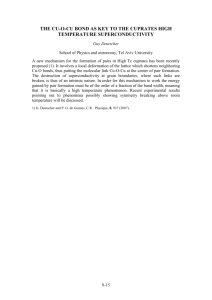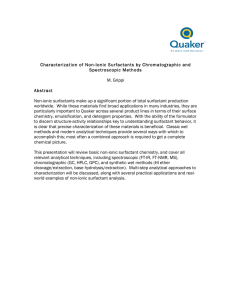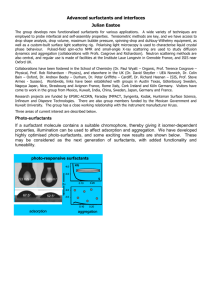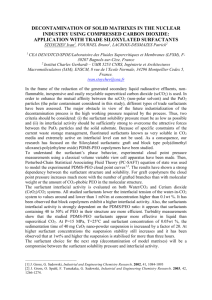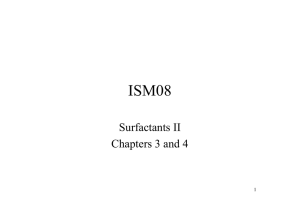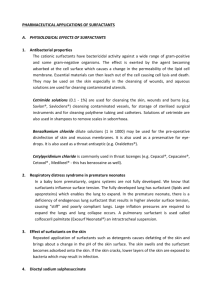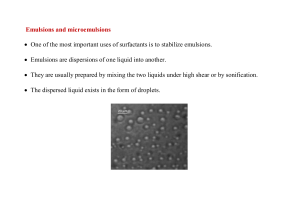SOFT MATTER
advertisement
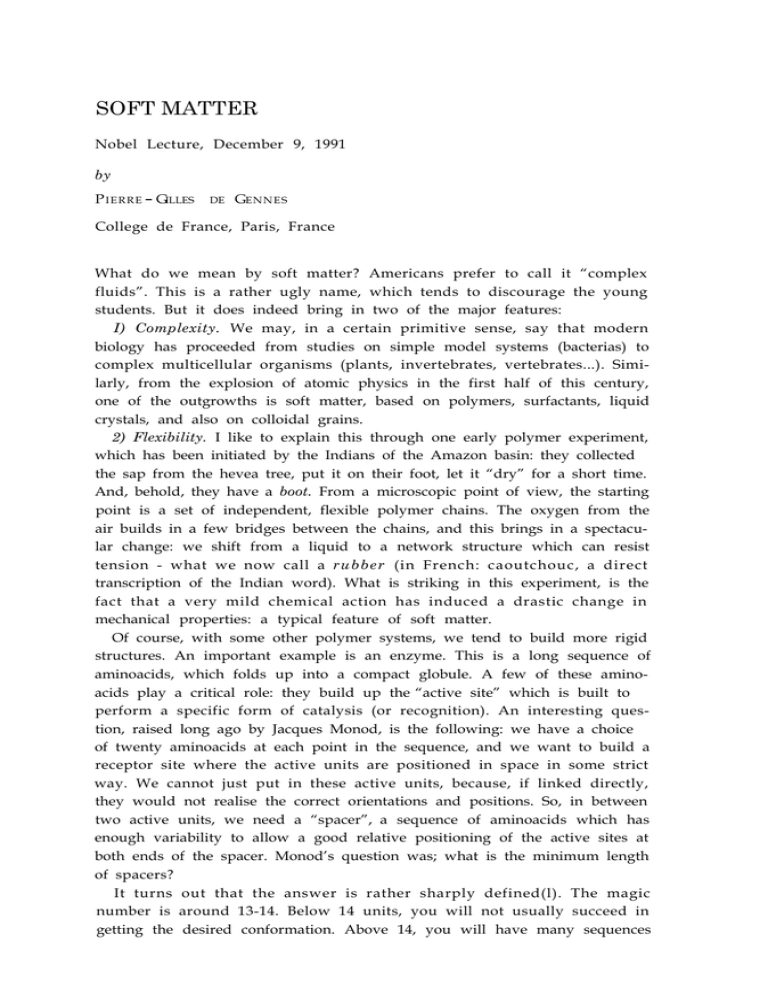
SOFT MATTER Nobel Lecture, December 9, 1991 by P I E R R E - GILLES DE GE N N E S College de France, Paris, France What do we mean by soft matter? Americans prefer to call it “complex fluids”. This is a rather ugly name, which tends to discourage the young students. But it does indeed bring in two of the major features: I) Complexity. We may, in a certain primitive sense, say that modern biology has proceeded from studies on simple model systems (bacterias) to complex multicellular organisms (plants, invertebrates, vertebrates...). Similarly, from the explosion of atomic physics in the first half of this century, one of the outgrowths is soft matter, based on polymers, surfactants, liquid crystals, and also on colloidal grains. 2) Flexibility. I like to explain this through one early polymer experiment, which has been initiated by the Indians of the Amazon basin: they collected the sap from the hevea tree, put it on their foot, let it “dry” for a short time. And, behold, they have a boot. From a microscopic point of view, the starting point is a set of independent, flexible polymer chains. The oxygen from the air builds in a few bridges between the chains, and this brings in a spectacular change: we shift from a liquid to a network structure which can resist tension - what we now call a rubber (in French: caoutchouc, a direct transcription of the Indian word). What is striking in this experiment, is the fact that a very mild chemical action has induced a drastic change in mechanical properties: a typical feature of soft matter. Of course, with some other polymer systems, we tend to build more rigid structures. An important example is an enzyme. This is a long sequence of aminoacids, which folds up into a compact globule. A few of these aminoacids play a critical role: they build up the “active site” which is built to perform a specific form of catalysis (or recognition). An interesting question, raised long ago by Jacques Monod, is the following: we have a choice of twenty aminoacids at each point in the sequence, and we want to build a receptor site where the active units are positioned in space in some strict way. We cannot just put in these active units, because, if linked directly, they would not realise the correct orientations and positions. So, in between two active units, we need a “spacer”, a sequence of aminoacids which has enough variability to allow a good relative positioning of the active sites at both ends of the spacer. Monod’s question was; what is the minimum length of spacers? It turns out that the answer is rather sharply defined(l). The magic number is around 13-14. Below 14 units, you will not usually succeed in getting the desired conformation. Above 14, you will have many sequences Pierre Gilles de Gennes 9 which can make it. The argument is primitive; it takes into account excluded volume effects, but it does not recognise another need for a stable enzyme - namely that the interior should be built preferably with hydrophobic units, while the outer surface must be hydrophilic. My guess is that this cannot change the magic number by much more than one unit. Indeed, when we look at the spacer sizes in a simple globular protein like myosin, we see that they are not far from the magic number. Let me return now to flexible polymers in solution, and sketch some of their strange mechanical properties. One beautiful example is the four roller experiment set up by Andrew Keller and his coworkers(2). Here, a dilute solution of coils is subjected to a purely longitudinal shear. If the exit trajectory is well chosen (in the symmetry plane of the exit channel), the molecules are stressed over long times. What is found is that, if the shear rate P, exceeds a certain threshold value f,, an abrupt transition takes place, and the medium becomes birefringent. This is what I had called a “coilstretch transition”(3). When the shear begins to open the coil, it offers more grip to the flow, and opens even more... leading to a sharp transition. Here, we see another fascinating aspect of soft matter - the amazing coupling between mechanics and conformations. Indeed, Keller showed that rather soon (at shear rates jc > fc, the chains break), and they do so very near to their midpoint - a spectacular result. Another interesting feature of dilute coils is their ability to reduce the losses in turbulent flows. This is currently called the Toms effect. But in actual fact it was found, even before Toms, by Karol Mysels(4). He is here today, to my great pleasure. Together with M. Tabor, we tried to work out a scaling model of coils in a turbulent cascade(5), but our friends in mechanics think that it is not realistic, the future will tell what the correct answer is. I have talked a lot about polymers. It would be logical to do the same with colloids, or - as I like to call it - “ultra divided matter”. But since I just gave another talk with this title at the Nobel symposium in Göteborg, I will omit the subject, in spite of its enormous practical importance. Let me rather switch to surfactants, molecules with two parts: a polar head which likes water, and an aliphatic tail which hates water. Benjamin Franklin performed a beautiful experiment using surfactants; on a pond at Clapham Common, he poured a small amount of oleic acid, a natural surfactant which tends to form a dense film at the water-air interface. He measured the volume required to cover all the pond. Knowing the area, he then knew the height of the film, something like three nanometers in our current units. This was to my knowledge the first measurement of the size of molecules. In our days, when we are spoilt with exceedingly complex toys, such as nuclear reactors or synchrotron sources, I particularly like to describe experiments of this Franklin style to my students. Surfactants allow us to protect a water surface, and to generate these beautiful soap bubbles, which are the delight of our children. Most of our understanding of these soap bubbles is due to a remarkable team, Mysels, Shinoda and Frankel, who wrote the book on this subject(6). Unfortunately, 10 Physics 1991 this book is now very hard to find, I very much hope that it will be reprinted. Long ago Françoise Brochard, Jean-François Lennon and I(7) became interested in some bilayer systems, where we have two sheets of surfactant, each pointing towards the neighbouring water. A related (although more complex) system of this type is a red blood cell. For many years it had been known that, when observed under phase contrast, these cells flicker. - It was sometimes believed that this flicker reflected an instability of a living system under non-equilibrium conditions. Ultimately, the thing is simpler. The essential property of insoluble bilayers is that they optimise their area at fixed surfactant number. Thus, the energy is stationary with respect to area: the surface tension vanishes. This means that the fluctuations in shape of these deflated cells, or “vesicles”, are huge: the flicker is just an example of Brownian motion for a very flexible object. What Jean-François had done was to measure space time correlations for the flicker. Françoise then showed that they could be understood from a model containing no surface tensions, but only curvature energies plus viscous forces - another good example of soft matter. This was, in fact, one of the starting points for many studies on surfactant bilayers, pioneered by W. Helfrich and, on a more formal side, on random surfaces especially with D. Nelson. One of the great successes in this field has been the invention of the “sponge phase” of microemulsions(8,9). But, more generally, it is amusing to learn from these people that there is some overlap in thought between the highbrow string theories and the descriptions of soaps! Let me now move to another corner in our garden - liquid crystals. Here, I must pay tribute first to two great pioneers: i) Georges Friedel, who was the first to understand exactly what is a liquid crystal, and what are the main types; ii) Charles Frank, who (after some early work of Oseen) constructed the elastic theory of nematics, and described also a number of their topological defects (“disclinations”). I will talk here only about the smectics. Observing certain defects (“focal conics”) in smectics, Friedel was able to prove that their structure must be a set of liquid, equidistant, deformable layers(l0). By observations at the one hundred micron scale, he was thus able to infer the correct structure at the ten Å scale - an amazing achievement. Smectics bring me naturally to another important feature of complex fluids - namely that, in our days, it is sometimes possible to create new forms of matter. The sponge phase quoted above was an example. Another striking case was the invention of ferroelectric smectics by R.B. Meyer, in Orsay, circa 1975. He thought about a certain molecular arrangement, with chiral molecules, which should automatically generate a phase (the “C* phase”) carrying a non-zero electric dipole. Within a few months, our local chemists had produced the right molecule, and the first liquid ferroelectric was born!(ll). In our days, these materials may become very important for display purposes, they commute l0 3 times faster than the nematics in our wrist-watches. Pierre-Gilles de Gennes 11 Another case of far smaller importance, but amusing, is the “ferrosmectic” constructed by M. Veyssié and P. Fabre. The starting point is a water based ferrofluid; a suspension of very fine magnetic particles. (Ferrofluids were invented long ago by R. Rosensweig, and have many amazing properties). Here, what is done, is to prepare a “club sandwich” bilayerLferrofluid 1 bilayerl . . . A system like this, subjected to a magnetic field H, is happier when H is parallel to the layers. It is then interesting to observe the sandwich, with a polarizing microscope, in the frustrated situation where H’ is normal to the layers. At very small H, nothing is seen. But beyond a certain weak threshold H c, figures like flowers grow in the field(l2). We understand this as a two step process a) just above threshold there is a chemical undulation instability b) later, focal conics appear, with a basic size imposed by the original undulation, but also with smaller conics (which are required to fill space correctly). This “club sandwich” is ultimately detecting rather weak magnetic fields (- 30 gauss). Let me quote still another new animal: the Janus grains, first made by C. Casagrande and M. Veyssié. The god Janus had two faces. The grains have two sides: one apolar, and the other polar. Thus, they have certain features in common with surfactants. But there is an interesting difference if we consider the films which they make, for instance at a water 1 air interface. A dense film of a conventional surfactant is quite impermeable. On the other hand, a dense film of Janus grains always has some interstices between the grains, and allows for chemical exchange between the two sides; “the skin can breathe”. This may possibly be of some practical interest. The first technique used to make the Janus grains was based on spherical particles, half embedded in a plastic and silanated on the accessible side( 13). This produces only microquantities of material. But a group at Goldschmidt(l4) research invented a much more clever pathway. The starting point is a collection of hollow glass particles, which are available commercially. There the outer surface is hydrophobized, and finally the particles are crushed. The resulting platelets have one side hydrophilic and one side hydrophobic. They are irregular, but they can be produced in tons. I would like now to spend a few minutes thinking about the style of soft matter research. One first, major, feature, is the possibility of very simple e x p e r i m e n t s - in the spirit of Benjamin Franklin. Let me quote two examples. The first concerns the wetting of fibers. Usually a fiber, after being dipped in a liquid, shows a string of droplets, and thus, for some time, people thought that most common fibers were non-wettable. F. Brochard analysed theoretically the equilibria on curved surfaces, and suggested that in many cases we should have a wetting film on the fiber, in between the droplets. J.M. di Meglio and D. Queré established the existence, and the thickness, of the film, in a very elegant way(l5). They created a pair of neighbouring droplets, one small and one large, and showed that the small one emptied slowly into the big one (as capillarity wants it to go). Measuring the speed of the process, they could go back to the thickness of the film 12 Physics 1991 which lies on the fiber and connects the two droplets: the Poiseuille flow rates in the film are very sensitive to thickness. Another elegant experiment in wetting concerns the collective modes of a contact line; the edge of a drop standing on a solid. If one distorts the line by some external means, it returns to its equilibrium shape with a relaxation rate dependent upon the wavelength of the distortion, which we wanted to study. But how could we distort the line? I thought of very complex tricks, using electric fields from an evaporated metal comb, or other, even worse, procedures. But Thierry Ondarcuhu came up with a simple method. 1) He first prepared the unperturbed contact line L by putting a large droplet on a solid. 2) He then dipped a fiber in the same liquid, pulled it out, and obtained, from the Rayleigh instability, a very periodic string of drops. 3) He laid the fiber on the solid, parallel to L, and generated a line of droplets on the solid. 4) He pushed the line L (by tilting the solid), up to the moment where L touched the droplets; then coalescence took place, and he had a single, wavy line on which he could measure relaxation rates(16). I have emphasized experiments more than theory. Of course we need some theory when thinking of soft matter. And in fact some amusing theoretical analogies sometimes show up between soft matter and other fields. One major example is due to S.F. Edwards(l7). Edwards showed a beautiful correspondence between the conformations of a flexible chain and the trajectories of a non relativistic particle; the statistical weight of the chain corresponding to the propagator of the particle. In the presence of external potentials, both systems are ruled by exactly the same Schrödinger equation! This observation has been the key to all later developments in polymer statistics. Another amusing analogy relates the smectics A to superconductors. It was discovered simultaneously by the late W. McMillan (a great scientist, who we all miss) and by us. Later, it has been exploited artistically by T. Lubensky and his colleagues(l8). Here again, we see a new form of matter being invented. We knew that type II superconductors let in the magnetic field in the form of quantized vortices. The analog here is a smectic A inside which we add chiral solutes, which play the role of the field. In some favorable cases, as predicted in 1988 by Lubensky, this may generate a smectic phase drilled by screw dislocations - the so called A* phase. This was discovered experimentally only one year later by Pindak and coworkers(19), a beautiful feat. Let me now end up this sentimental journey into soft matter, with a brief mention of my companions. Some were met during the way, like Jean Jacques, a great inventor of liquid crystals, or Karol Mysels, the undisputed master of surfactant science. Some others were with me all along the way; Henri Benoit and Sam Edwards, who taught me polymer science; Jacques des Cloizeaux and Gerard Jannink, who have produced a deep theoretical book on this subject. Finally, an inner core of fellow travelers, over all forms Pierre-Gilles de Gennes 13 of land and sea: Phil Pincus, Shlomo Alexander, Etienne Guyon, Madeleine Veyssié; and last but not least, Françoise Brochard - sans laquelle les chases ne seraient que ce qu’elles sont. The final lines are not mine: they come from an experiment on soft matter, after Boudin, which is shown on the following figure. 14 Physics 1991 An English translation might run like this: “Have fun on sea and land Unhappy it is to become famous Riches, honors, false glitters of this world All is but soap bubbles” No conclusion could be more appropriate today. REFERENCES: 1. P G de Gennes, in Pvor. 2nd Conf. “Physique théorique et Biologie”. Editions CNRS 1969 (15 Quai A. France 75007 Paris, France). 2. J.A. Odell, A. Keller, in Polymer-flow Interactions (ed. I. Rabin), AIP, New York 1985 ; Av. Keller, J. Odell, Coll. Polym. Sci., 263, 181 (1985). 3. P.G. de Gennes, J. Chem. Phys., 60, 5030 (1974). 4. For a historical review see K. Mysels, Chem. Eng. Prog., Symposium series, 67, 45, (1971). 5. M. Tabor, P.G. de Gennes, Europhys. Lett., 2, 519 (1986) P.G. de Gennes, Physica, 140 A, 9 (1986). 6. K. Mysels, K. Shinoda, S. Frankel, Soap Films , Pergamon, London (1959). 7. F. Brochard, J.F. Lennon, J. Physique (Paris), 36, 1035 (1976). 8. G. Porte, J. Marignan, P. Bassereau, R. May, J. Physique (Paris), 49, 511 (1988). 9. D. Roux, M.E. Cates, Proceedings of the 4th Nishinomya-Yukawa Symposium, Springer (to be published). 10. G. Friedel, Annales de Physique, 18, 273 (1922). 11. R.B. Meyer, L. Liebert, L. Strzelecki, P. Keller, J. Physique L. 69 (1975). 12. P. Fabre, C. Casagrande, M. Veyssié, V. Cabuil, R. Massart, “Ferrosmectics : A new Magnetic and Mesomorphic Phase”, Phys. Rev. Lett., 64, 539 (1990). 13. C. Casagrande, M. Veyssié, C.R. Acad. Sci. (Paris), 306 II, 1423 (1988). C. Casagrande, P. Fabre, M. Veyssié, E. Raphael, Europhys. Lett., 9, 251 (1989). 14. B. Grüining, U. Holtschmidt, G. Koerner, G. Rössmy US Patent no 4, 715, 986 (Dec 1987). 15. J.M. di Meglio, CR. Acad. Sci. (Paris), 303 II, 437 (1986). 16. T. Ondarcuhu, M. Veyssié, Nature, 352, 418 (1991). 17. S.F. Edwards, Proc. Phys. Sot. (London), 85, 613 (1965). 18. S.R. Renn, T. Lubensky, Phys. Rev., A 38, 2132 (1988). 19. J.W. Goodby, M.A. Waugh, S.M. Stein, E. Chin, R. Pindak, J.S. Patel, J. Am. Chem. Soc., 111, 8119 (1989).
